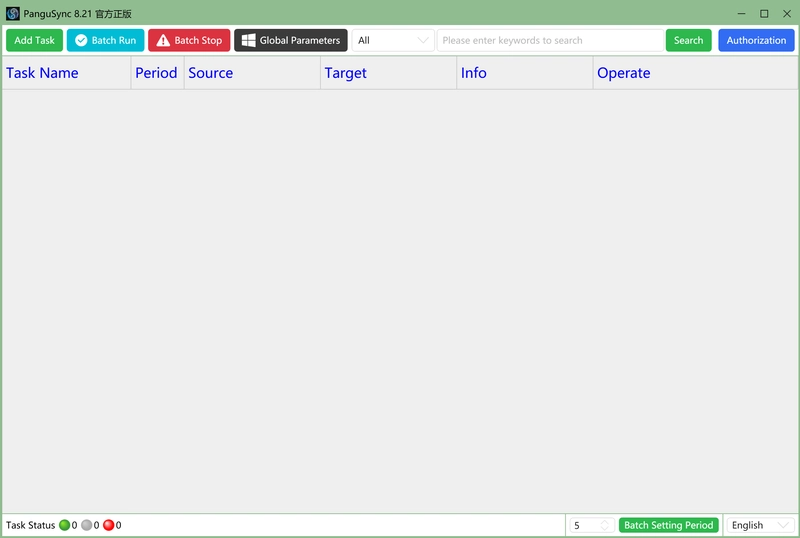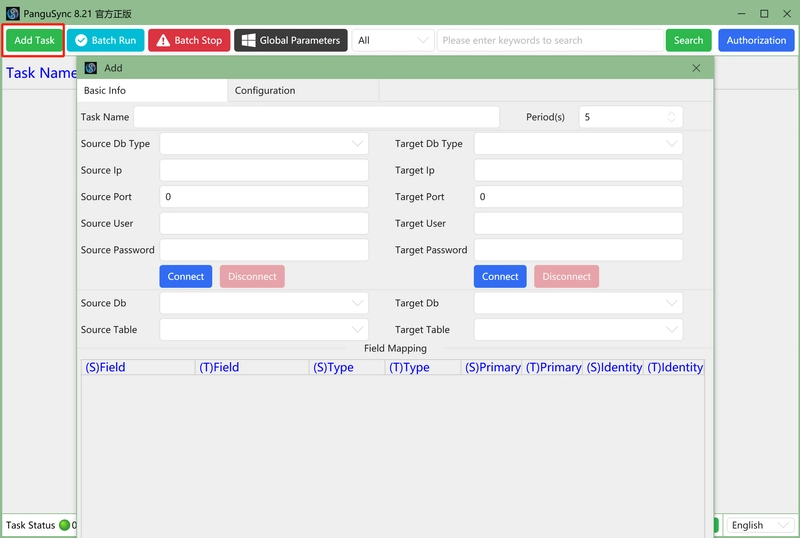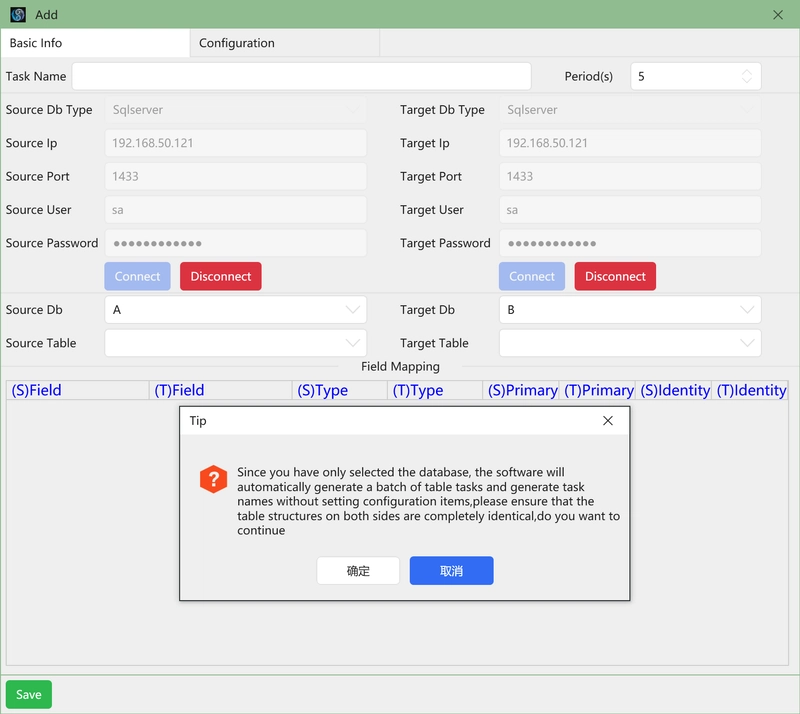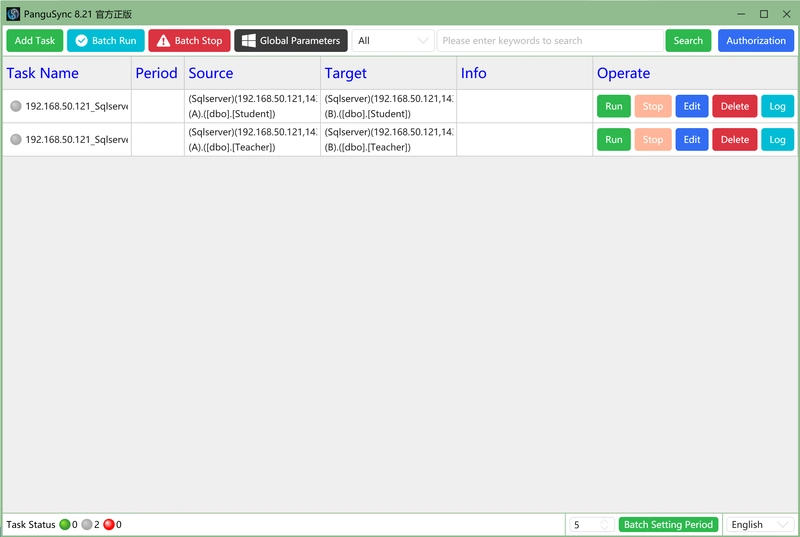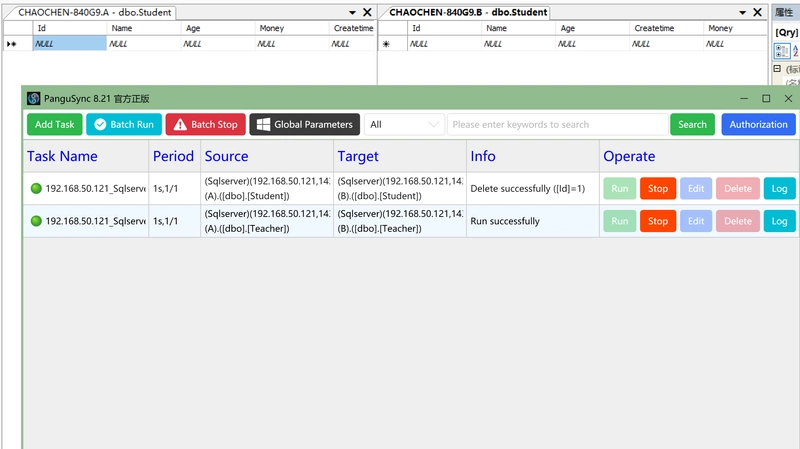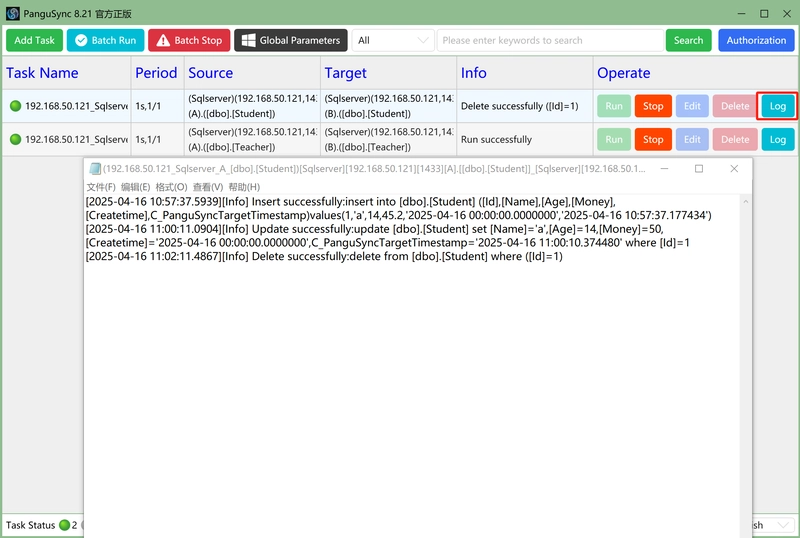PanguSync: A High-Performance Database Synchronization Tool
PanguSync is a high-performance database synchronization software. In certain scenarios where SQL Server database synchronization is required, traditional subscription/publication methods are cumbersome to deploy and often have low success rates. Today, we switch to this synchronization tool, which acts as a powerful weapon for programmers or IT operations teams. Database synchronization—whether for SQL Server or MySQL, unidirectional or bidirectional, homogeneous or heterogeneous, full or incremental, cloud-to-cloud or on-premises—becomes effortless, as this tool handles it seamlessly. Database Synchronization Tool Download Testing Synchronization Locally For a local test, we used two databases, A and B, each containing two tables with identical structures (as shown below). Our goal was to synchronize data from Database A to Database B. Configuring the Synchronization Task Open PanguSync: The main interface is clean and intuitive. Add a Task: Click "Add Task" to open the configuration window. Set Parameters: Task Name: Custom name for the task. Sync Cycle: Configure synchronization frequency. Source Database: Type (e.g., SQL Server), IP, port, username, and password. Target Database: Same parameters as above. Connect Databases: Select Database A as the source and Database B as the target. Since no specific tables were selected, the tool automatically generates sync tasks for all tables in the database. This feature saves time but requires identical table structures between source and target. Note: Primary keys are mandatory for incremental sync, and the tool supports single or composite primary keys. Generate Tasks: After confirmation, the tool generates sync tasks for all tables. Run Tasks: Initial Sync (First Run): Full data synchronization. Incremental Sync: Continuous real-time updates. Status Indicators: Gray: Task not started. Red: Error/terminated. Green: Running normally. Testing Sync Performance Insert Data: Adding a row to the stu table in Database A instantly replicates it to Database B. Update Data: Modifying the Money field from 45.2 to 50 in Database A triggers immediate sync to Database B. Delete Data: Deleting the row in Database A removes it instantly in Database B. Logging and Troubleshooting View Logs: The tool logs all SQL statements executed on the target database. Logs are split by date and retained for 30 days. Log Directory: Access logs via the software’s UI or directly in the Log folder. Why Choose PanguSync? Simplified Deployment: No complex setup compared to traditional methods. Versatility: Supports SQL Server, MySQL, heterogeneous/homogeneous databases, and cloud/on-premises environments. Real-Time Efficiency: Handles inserts, updates, and deletions seamlessly. Whether you’re syncing data "to the cloud or down to the trenches," PanguSync delivers unmatched reliability. Try it today and eliminate database synchronization headaches!

PanguSync is a high-performance database synchronization software. In certain scenarios where SQL Server database synchronization is required, traditional subscription/publication methods are cumbersome to deploy and often have low success rates. Today, we switch to this synchronization tool, which acts as a powerful weapon for programmers or IT operations teams. Database synchronization—whether for SQL Server or MySQL, unidirectional or bidirectional, homogeneous or heterogeneous, full or incremental, cloud-to-cloud or on-premises—becomes effortless, as this tool handles it seamlessly.
Database Synchronization Tool Download
Testing Synchronization Locally
For a local test, we used two databases, A and B, each containing two tables with identical structures (as shown below).
Our goal was to synchronize data from Database A to Database B.
Configuring the Synchronization Task
Open PanguSync: The main interface is clean and intuitive.
Add a Task: Click "Add Task" to open the configuration window.
Set Parameters:
Task Name: Custom name for the task.
Sync Cycle: Configure synchronization frequency.
Source Database: Type (e.g., SQL Server), IP, port, username, and password.
Target Database: Same parameters as above.
Connect Databases: Select Database A as the source and Database B as the target.
Since no specific tables were selected, the tool automatically generates sync tasks for all tables in the database. This feature saves time but requires identical table structures between source and target. Note: Primary keys are mandatory for incremental sync, and the tool supports single or composite primary keys.
Generate Tasks: After confirmation, the tool generates sync tasks for all tables.
Run Tasks:
Initial Sync (First Run): Full data synchronization.
Incremental Sync: Continuous real-time updates.
Status Indicators:
Gray: Task not started.
Red: Error/terminated.
Green: Running normally.
Testing Sync Performance
Insert Data: Adding a row to the stu table in Database A instantly replicates it to Database B.
Update Data: Modifying the Money field from 45.2 to 50 in Database A triggers immediate sync to Database B.
Delete Data: Deleting the row in Database A removes it instantly in Database B.
Logging and Troubleshooting
View Logs: The tool logs all SQL statements executed on the target database. Logs are split by date and retained for 30 days.
Log Directory: Access logs via the software’s UI or directly in the Log folder.
Why Choose PanguSync?
Simplified Deployment: No complex setup compared to traditional methods.
Versatility: Supports SQL Server, MySQL, heterogeneous/homogeneous databases, and cloud/on-premises environments.
Real-Time Efficiency: Handles inserts, updates, and deletions seamlessly.
Whether you’re syncing data "to the cloud or down to the trenches," PanguSync delivers unmatched reliability. Try it today and eliminate database synchronization headaches!





























![[Webinar] AI Is Already Inside Your SaaS Stack — Learn How to Prevent the Next Silent Breach](https://blogger.googleusercontent.com/img/b/R29vZ2xl/AVvXsEiOWn65wd33dg2uO99NrtKbpYLfcepwOLidQDMls0HXKlA91k6HURluRA4WXgJRAZldEe1VReMQZyyYt1PgnoAn5JPpILsWlXIzmrBSs_TBoyPwO7hZrWouBg2-O3mdeoeSGY-l9_bsZB7vbpKjTSvG93zNytjxgTaMPqo9iq9Z5pGa05CJOs9uXpwHFT4/s1600/ai-cyber.jpg?#)












































































































































![[The AI Show Episode 144]: ChatGPT’s New Memory, Shopify CEO’s Leaked “AI First” Memo, Google Cloud Next Releases, o3 and o4-mini Coming Soon & Llama 4’s Rocky Launch](https://www.marketingaiinstitute.com/hubfs/ep%20144%20cover.png)





































































































































































































![Rogue Company Elite tier list of best characters [April 2025]](https://media.pocketgamer.com/artwork/na-33136-1657102075/rogue-company-ios-android-tier-cover.jpg?#)







































































_Andreas_Prott_Alamy.jpg?width=1280&auto=webp&quality=80&disable=upscale#)









































































































![Apple Watch Series 10 Back On Sale for $299! [Lowest Price Ever]](https://www.iclarified.com/images/news/96657/96657/96657-640.jpg)
![EU Postpones Apple App Store Fines Amid Tariff Negotiations [Report]](https://www.iclarified.com/images/news/97068/97068/97068-640.jpg)
![Apple Slips to Fifth in China's Smartphone Market with 9% Decline [Report]](https://www.iclarified.com/images/news/97065/97065/97065-640.jpg)

































































































































